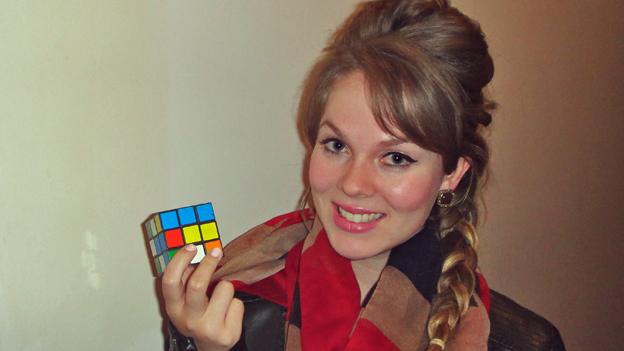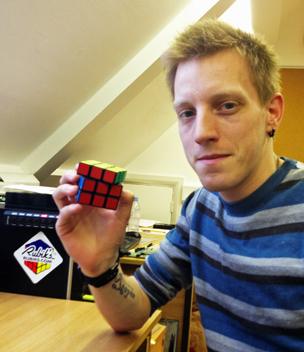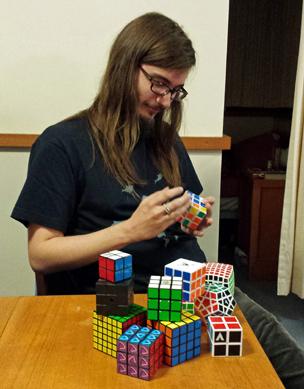The people who are still addicted to the Rubik's Cube
- Published
The Rubik's Cube is the best selling puzzle toy of all time
In the 1980s Rubik's Cubes seemed to be everywhere, but there are still legions of people obsessed with the coloured puzzles.
The record for a human is 5.55 seconds. A robot can do it in 3.253. Labour Party leader Ed Miliband takes one-and-a-half minutes.
Most people - despite toiling over it for hours - have probably never managed it.
But 40 years after its birth, the Rubik's Cube continues to beguile, frustrate and - like a Filofax or Walkman - evoke its 1980s heyday when schools were full of children puzzling over its brightly coloured squares.
The Magic Cube was invented in 1974 by Hungarian architecture professor Erno Rubik. After being relaunched in 1980 as the Rubik's Cube, it sold an estimated 350 million around the world.
As an object it has charm - its colours, the distinctive rattle as the pieces turn, a pleasing feel in the hand. And for those who lose patience with the puzzle, it is eminently throwable. Not at anyone, of course.
The traditional cube has six faces each with three squares by three. Every face is a different colour - white, red, blue, orange, green and yellow. That is, until the cube has been thoroughly scrambled. The challenge then is to return it to its original state with each side a single colour. It all relies on impressive engineering - an internal pivot allowing both the rows and columns to turn.
It is devilishly difficult. There are said to be 43 quintillion permutations - the number of possible positions the cube can hold.

Today at least there are YouTube tutorials. When the schoolboy Miliband learnt how to crack it, there were no such short cuts.
Some see it as a challenge - like swimming the Channel or climbing Everest - that must be overcome.
Graham Parker, a builder in Hampshire, solved it in 2009, external after 26 years of trying. He wept when he completed it. It had caused him backache and put a strain on his marriage, he admitted.
Many of today's fans weren't alive during the 1980s craze. Connor Albright, a high school student in Las Vegas "devotes a lot of time" to practising. He has 20-30 cubes and averages 20 seconds.
There was a spike in sales in the US in 2006, attributed to Will Smith's movie The Pursuit of Happyness, in which Smith's homeless character solves a Rubik's Cube and impresses a businessman.

Carina Vermooten: "I play with it instead of going on my phone"
Carina Vermooten, a digital manager in Pretoria, keeps one in her handbag. "Whenever I have a spare moment or am waiting in line I play with it instead of going on my phone." She's no expert - she completed it as a child once but says that was a "fluke".
Extreme devotees find completing it easy. Their focus is on speed, stamina or overcoming extra obstacles - such as being blindfolded.

Billy Jeffs
The speed world record for a single attempt is 5.55 seconds, set by Dutchman Mats Valk last year. The world championship is determined by averaging three attempts. The current champion is 18-year-old Australian Feliks Zemdeg who averaged 8.18 seconds last year. To ensure fairness, a computer generates a randomised cube which all the competitors are given. The record for most Rubik's cubes solved in 24 hours is 4,786, set by Milán Baticz of Hungary, external.
Billy Jeffs, an IT worker living in Hertfordshire, had no interest in Rubik's Cube until getting one from Secret Santa at work four years ago. He was wagered £20 by a colleague that he couldn't solve it by the following morning. He went home and watched a YouTube video. A few hours later he'd finished. "When you learn to solve it the first time you either get the bug or not." Now he can do it in 10.15 seconds.
Aficionados of the cube learn hundreds of algorithms - a set of moves. They must also learn to have quick hands. A layman watching an expert solve a cube will notice that instead of truly grasping it, they almost seem to flick it in order to rotate it.
It is the blindfold event where Jeffs excels. The clock starts with player being given a cube which he must memorise. The blindfold goes on and the competitor can begin solving it. Jeffs can complete it in 90 seconds, making him the sixth fastest in the UK.

Filip Drnovsek Zorko
There is a one-handed world record - held by Zemdegs - of 9.03 seconds. Fakhri Raihaan of Indonesia boasts the feet-only record of 27.93 seconds.
Jeffs admits to being tied to his cubes: "It's quite hard to leave the house without one. I have three in my bag." Each is a different size - 5x5, 4x4 as well as the conventional 3x3.
Filip Drnovsek Zorko, a Slovenian studying at Cambridge University, has 12 cubes in his room. They vary massively in quality, he says. Some can stick. To get a really smooth one he got one shipped over from a company in the US that checks and services them. "It's my favourite. It's immediately obvious to anyone who tries it that it moves better than the others."
Drnovsek Zorko, who earlier this month was on the winning University Challenge team, says his friends sometimes produce one for him at social gatherings. "It's a fantastic party trick," he says. But it's more than that. "I like having something to do with my hands when I'm watching a film or something. You can keep turning it mindlessly."
Its difficulty is part of the attraction, says Vermooten. She has tried looking at online tutorials to no avail. "It's impossible, one of the biggest secrets in the world. I like the fact it's almost a mystery."
Follow @BBCNewsMagazine, external on Twitter and on Facebook, external
Did it take you longer than Graham's 26 year record to solve the Rubik's Cube?
What did you overcome? Tell us your story.